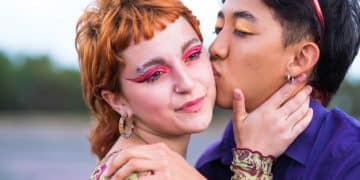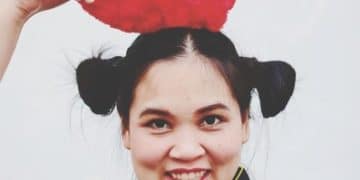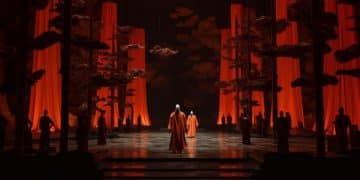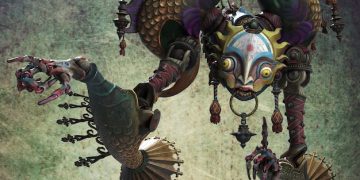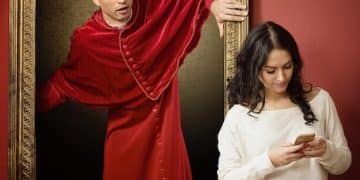The Evolution of Chinese Drama Makeup: A Decade of Trends and Techniques
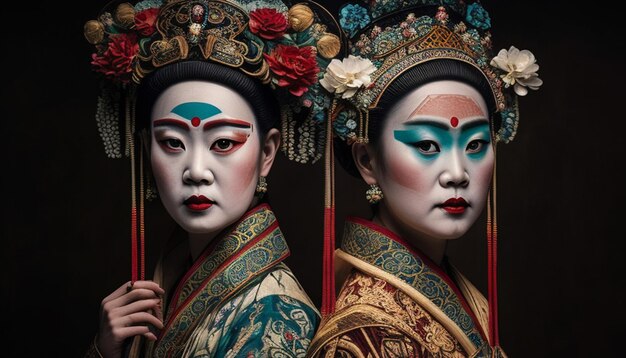
Advertisements
The evolution of Chinese drama makeup over the past decade has seen a significant transformation, influenced by changing beauty standards, technological advancements, and the desire to authentically represent historical and contemporary narratives.
Chinese dramas have captivated audiences worldwide, and one of the most fascinating aspects is the artistry of their makeup. Let’s explore the evolution of Chinese drama makeup: a decade of trends and techniques, uncovering the secrets behind the stunning transformations seen on screen.
Anúncios
A Shift in Beauty Standards: From Ornate to Natural
Over the past decade, beauty ideals in China, and consequently in Chinese dramas, have undergone a noticeable shift. The once-dominant preference for heavily stylized and ornate makeup has gradually given way to a more natural and subtle aesthetic. This change reflects broader trends in beauty and fashion, emphasizing authenticity and individual expression.
The Decline of Heavy Foundation
In earlier dramas, a thick layer of foundation was commonly used to create a flawless, porcelain-like complexion. Today, makeup artists are opting for lighter, more breathable foundations that allow the actors’ natural skin to peek through. This approach results in a more realistic and relatable appearance.
Anúncios
- Lighter foundations enhance the natural skin texture.
- Breathable formulas prevent a cakey or artificial look.
- Subtle concealers correct imperfections without masking the entire face.
Embracing Natural Eyebrows
Another significant change is the way eyebrows are styled. Years ago, sharply defined, often unnatural-looking eyebrows were the norm. Now, the trend is to enhance the natural shape of the eyebrows with subtle filling and shaping techniques. This creates a softer, more harmonious look.
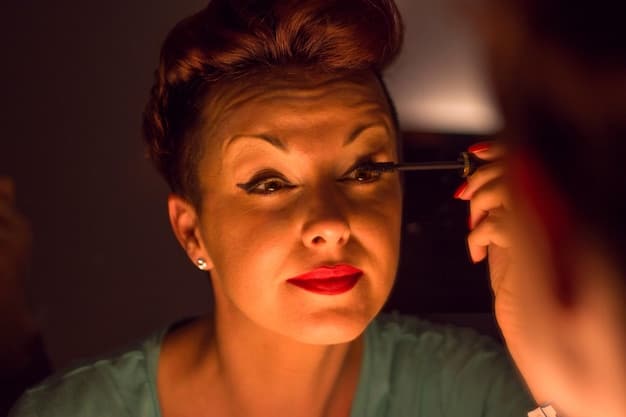
In conclusion, the shift in beauty standards from ornate to natural has revolutionized the approach to makeup in Chinese dramas. This transition reflects a broader cultural movement that values authenticity and embraces individual beauty.
Historical Accuracy vs. Modern Interpretation
Chinese dramas often depict historical periods, which necessitates careful consideration of makeup styles. While maintaining historical accuracy is crucial, makeup artists also strive to create looks that resonate with modern audiences. This balancing act requires extensive research and creative interpretation.
Researching Historical Makeup
Before designing the makeup for a historical drama, makeup artists delve into historical texts, paintings, and artifacts to understand the makeup trends of the period. This research informs the selection of colors, techniques, and overall aesthetic.
- Consult historical records and artwork for accurate representation.
- Understand the social context and significance of different makeup styles.
- Collaborate with historians and cultural experts to ensure authenticity.
Adapting to Modern Sensibilities
While historical accuracy is important, makeup artists also make adjustments to appeal to contemporary viewers. For example, they may soften harsh lines, brighten colors, or use more modern application techniques to create a look that is both historically plausible and visually appealing to modern audiences.
Historically accurate makeup may sometimes appear too severe or outdated for modern tastes. Therefore, subtle modifications are made to enhance the actors’ features and create a more engaging visual experience. This involves blending traditional techniques with modern beauty standards.
In conclusion, the challenge of balancing historical accuracy with modern sensibilities requires makeup artists to be both historians and artists. They study the past while creating visuals that resonate with contemporary audiences.
The Influence of Technology: HD and Beyond
The advent of high-definition (HD) cameras and later 4K and beyond has had a profound impact on makeup techniques in Chinese dramas. HD cameras capture every detail, exposing imperfections and requiring makeup artists to adopt new strategies to create flawless yet natural-looking complexions.
HD-Friendly Foundations
Traditional heavy foundations can appear cakey and unnatural under HD cameras. Makeup artists now rely on lightweight, HD-friendly foundations that provide coverage without looking heavy. These foundations are formulated to diffuse light and minimize the appearance of pores and wrinkles.
The transition to HD-friendly foundations has necessitated a shift in application techniques. Instead of applying a thick layer of foundation, makeup artists use a stippling or buffing motion to blend the product seamlessly into the skin.
Airbrushing Techniques
Airbrushing has become an increasingly popular technique for creating flawless complexions in Chinese dramas. Airbrushing involves using a compressor to spray a fine mist of foundation onto the skin, creating an even and natural-looking finish.
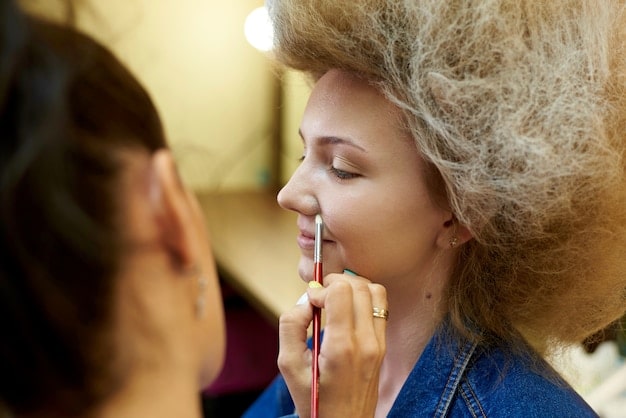
In conclusion, technology has revolutionized makeup techniques in Chinese dramas, pushing makeup artists to innovate and adapt to the demands of high-definition filming.
Color Palettes: Trends and Meanings
The use of color in Chinese drama makeup is deeply symbolic, with different colors conveying different meanings and emotions. Over the past decade, there have been shifts in the popularity and application of various color palettes, reflecting evolving cultural trends and aesthetic preferences.
The Rise of Neutral Tones
While bold colors still have their place, neutral tones have become increasingly popular in Chinese drama makeup. Earthy browns, soft peaches, and muted roses create a subtle and sophisticated look that complements a wide range of skin tones and outfits.
Neutral tones are particularly favored in modern dramas, where the emphasis is on realism and relatability. These colors enhance the actors’ natural features without overpowering their expressions.
The Enduring Appeal of Red
Red remains an important color in Chinese drama makeup, particularly in historical dramas. Red symbolizes luck, prosperity, and joy, and is often used on the lips and cheeks to create a vibrant and auspicious look.
- Red lipstick is a classic choice for portraying powerful and confident female characters.
- Red blush adds a touch of vitality and youthfulness to the cheeks.
- Red eyeshadow can create a dramatic and alluring look.
In conclusion, color palettes play a vital role in shaping the visual narrative of Chinese dramas. Trends shift, but the symbolic power of color remains constant.
The Role of Accessories: Hair Ornaments and More
Accessories are an integral part of Chinese drama makeup, adding to the overall visual impact and enhancing the storytelling. Hair ornaments, in particular, have undergone significant changes in design and popularity over the past decade.
Elaborate Hair Ornaments in Historical Dramas
Historical dramas often feature elaborate hair ornaments that reflect the fashion trends of the period. These ornaments can range from simple hairpins to elaborate headdresses adorned with jewels, pearls, and feathers.
The design and arrangement of hair ornaments can convey a character’s social status, personality, and emotional state. For example, a wealthy and powerful queen may wear a heavy, ornate headdress, while a humble servant may wear a simple hairpin.
Minimalist Accessories in Modern Dramas
In contrast to the elaborate accessories seen in historical dramas, modern dramas tend to feature more minimalist accessories. Simple earrings, necklaces, and hair clips are used to add a touch of elegance without overwhelming the actors’ natural features.
The emphasis is on understated beauty and effortless style. Accessories are chosen to complement the actors’ outfits and enhance their overall appearance without drawing too much attention.
In conclusion, the role of accessories in Chinese drama makeup is multifaceted, serving both aesthetic and narrative purposes. The choice of accessories reflects the setting, characters, and overall tone of the drama.
The Influence of Korean and Western Beauty Trends
Chinese drama makeup has been influenced by beauty trends from both Korea and the West. Korean beauty trends, with their emphasis on natural skin and youthful glow, have had a particularly strong impact. Western beauty trends, such as contouring and highlighting, have also found their way into Chinese drama makeup.
Korean Beauty Influences
The Korean beauty philosophy emphasizes achieving a radiant and healthy complexion. This has led to the adoption of skincare-focused makeup techniques in Chinese dramas. Makeup artists prioritize prepping the skin with hydrating serums and moisturizers before applying makeup.
Korean beauty trends like the “glass skin” look, which involves creating a dewy and translucent complexion, have also become popular in Chinese dramas. This look is achieved using lightweight foundations, hydrating highlighters, and facial mists.
Western Beauty Influences
Western beauty trends like contouring and highlighting have been incorporated into Chinese drama makeup to add dimension and definition to the face. However, these techniques are often applied more subtly than in Western makeup, creating a softer and more natural look.
- Contouring is used to sculpt the cheekbones and jawline without creating harsh lines.
- Highlighting is used to accentuate the high points of the face and create a luminous glow.
In conclusion, the fusion of Korean and Western beauty trends has enriched Chinese drama makeup, resulting in a unique and innovative aesthetic.
| Key Aspect | Brief Description |
|---|---|
| 💄 Beauty Standards | Shift from ornate styles to natural, subtle looks. |
| 🎥 Technology Impact | HD filming requires lighter, HD-friendly makeup. |
| 🎨 Color Palettes | Neutral tones rise, red endures for symbolic meanings. |
| 🌏 Global Influences | Korean and Western beauty trends are subtly integrated. |
Frequently Asked Questions (FAQ)
▼
The trend has shifted from heavy, cakey foundations to lighter, HD-friendly formulations. Makeup artists now focus on achieving a natural, breathable complexion that looks flawless on screen.
▼
Red symbolizes luck, prosperity, and joy in Chinese culture. It’s often used on the lips and cheeks in historical dramas to create a vibrant and auspicious look, especially for powerful female characters.
▼
Makeup artists conduct thorough historical research and then creatively adapt elements to resonate with contemporary audiences. This involves softening harsh lines and brightening colors to create appealing looks.
▼
Accessories are vital, with elaborate hair ornaments in historical dramas reflecting social status and minimalist jewelry in modern dramas adding understated elegance. They enhance the characters’ visual presence.
▼
The focus on natural skin, seen in K-beauty, has promoted skincare-focused makeup. Western influences like contouring and highlighting are used subtly to enhance facial features for a natural yet defined look.
Conclusion
The evolution of Chinese drama makeup over the past decade reflects a dynamic interplay of cultural shifts, technological advancements, and global beauty influences. From embracing natural beauty standards to adapting to the demands of high-definition filming, makeup artists continue to innovate and create stunning transformations that captivate audiences worldwide.
